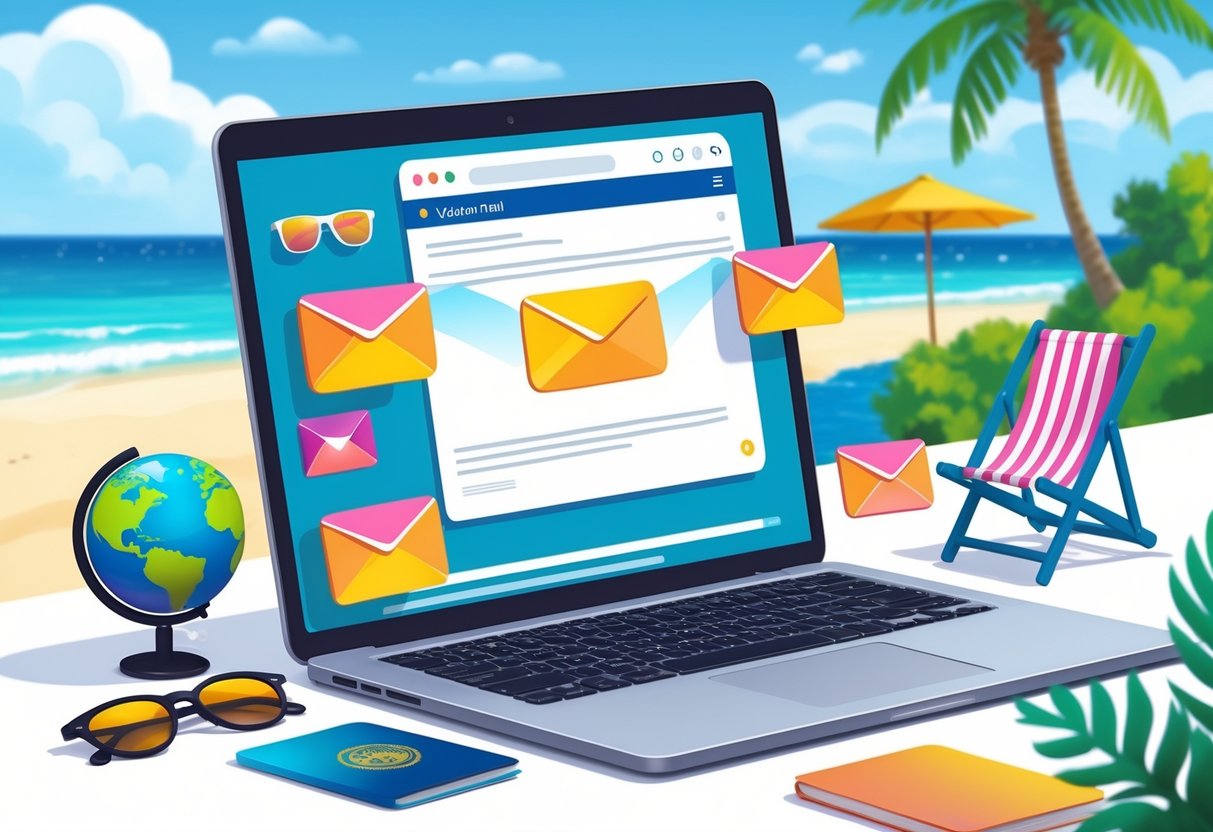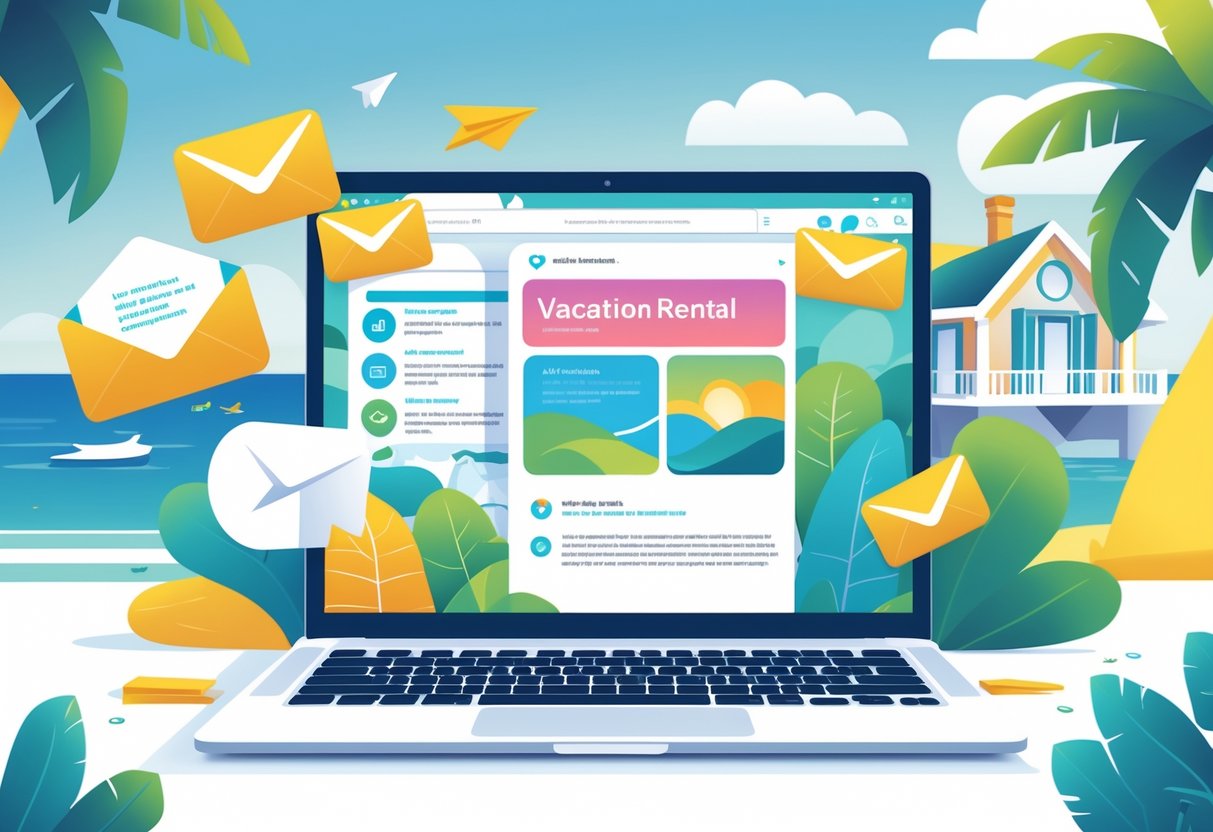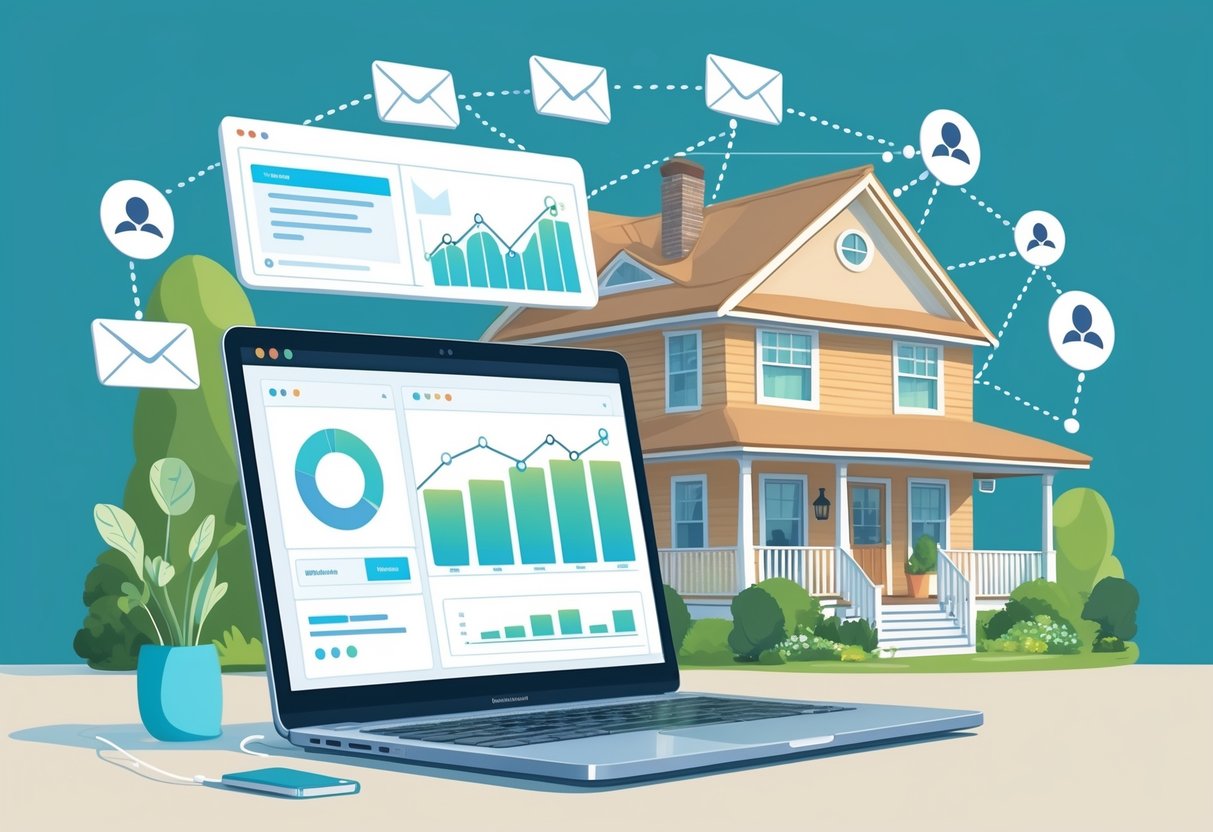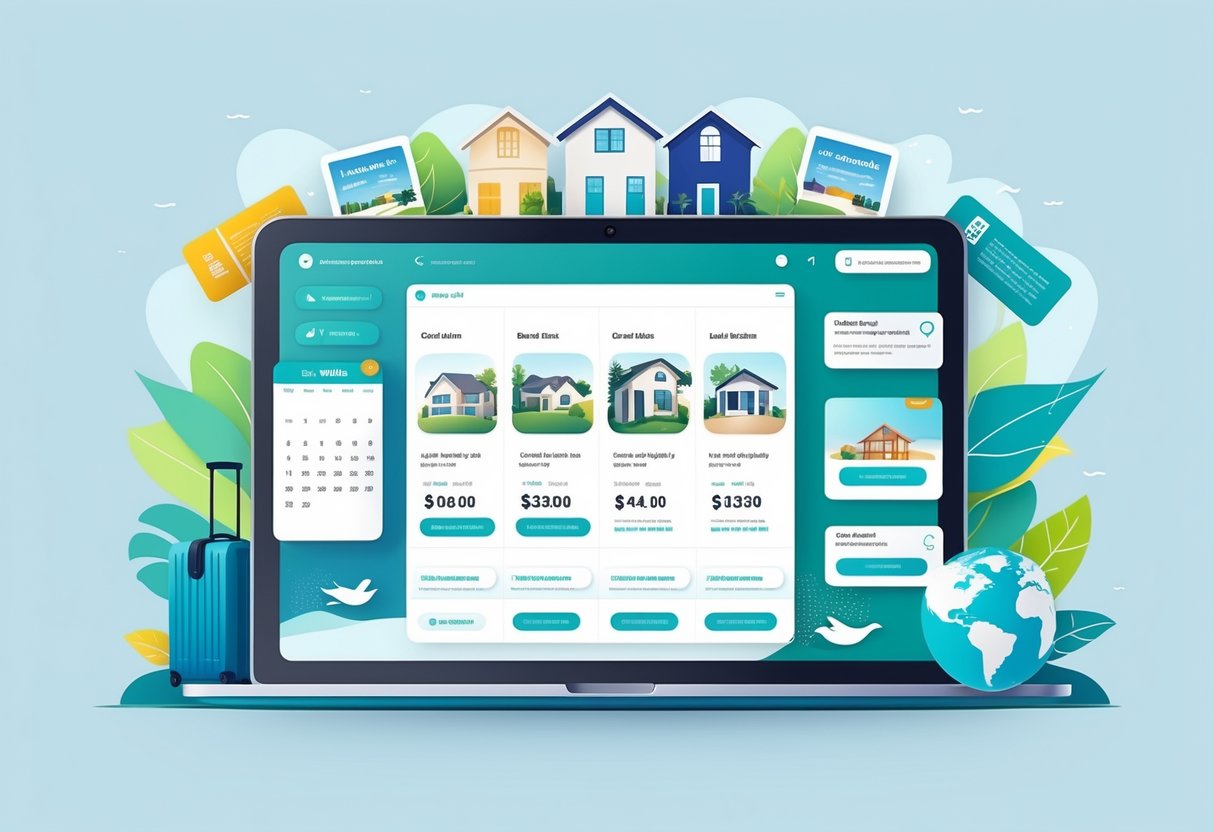Email marketing stands out as a powerful tool for vacation rental owners and property managers aiming to boost direct bookings and rely less on third-party platforms.
Platforms like Airbnb and Vrbo take hefty commissions, but with a smart email strategy, property managers can connect directly with guests and build relationships that actually drive repeat business.

Email marketing brings in an average return of $42 for every $1 spent. That’s a wild ROI, especially compared to paid ads where every click costs you.
By using their email lists, property managers can push last-minute deals, share exclusive offers, and stay on guests’ minds for the next trip.
Building a solid vacation rental email marketing strategy takes more than just collecting emails.
The best property managers set up automated welcome sequences, craft fun newsletters, and use data to tweak their campaigns.
You’ve got to give subscribers real value while nudging them toward direct bookings with personalized messages and perks.
Key Takeaways
- Email marketing delivers high ROI by letting you talk directly to guests, no ongoing ad spend required.
- Collecting emails through WiFi and pre-arrival forms helps you reach more than just the person who booked.
- Automated and personalized campaigns bump up repeat bookings and guest loyalty.
The Importance of Email Marketing for Vacation Rentals

Email marketing gives vacation rental owners a direct line to guests, and honestly, it beats the returns from paid ads and social media.
It’s a great way for property managers to cut down on those expensive third-party booking fees.
Benefits Over Other Marketing Channels
Email marketing brings in higher returns than most other channels for vacation rentals.
Property managers often see $36-42 in revenue for every $1 spent on email campaigns.
Social media posts? They only reach 2-5% of your followers unless you pay to boost them.
Email lands right in the inbox, with open rates around 20-25% in hospitality.
Owners can send messages tailored to guest preferences and booking history, which gets way more engagement than generic ads.
Email campaigns cost way less than Google or Facebook ads.
You’re not paying per click or impression, but you’re still keeping in touch with potential guests.
The cost-effective nature of email marketing lets vacation rental businesses save time and money while still seeing substantial returns.
Building Direct Communication with Guests
Email marketing opens up a direct line between owners and guests—no middlemen.
This makes it easy to share personal recommendations, local tips, and special deals.
Direct communication helps you build real relationships with past guests.
You can send welcome emails, check-in reminders, and friendly follow-ups after their stay.
Property managers can segment their lists by guest behavior, preferences, or demographics.
That way, you’re sending the right content to the right people.
Regular newsletters let owners highlight unique property features, local attractions, or upcoming events.
These keep your place top-of-mind when guests start planning another trip.
With email automation, you can send timely messages without having to remember every detail.
Automated sequences cover booking confirmations, pre-arrival info, and rebooking nudges.
Reducing Dependence on Booking Platforms
Email marketing helps property managers drive direct bookings and dodge those 10-20% platform fees.
You can send special offers and discounts just for your subscribers, encouraging them to book straight from your website instead of booking platforms.
When you use email, you control your guest data and conversations.
Booking platforms often make that tough or even block you from contacting guests directly.
Consistent email updates help build brand loyalty.
Loyal guests are more likely to book direct and tell their friends about your place.
You can also collect guest feedback and preferences, which helps you improve and build a repeat-customer database that skips platforms altogether.
Building and Growing Your Email List

If you want to grow your email list, you’ll need more than one trick.
The smartest owners mix collecting emails during the stay, offering cool incentives, and dropping sign-up forms in all the right spots.
Capturing Guest Emails During Stay
Check-in is prime time for collecting guest email addresses.
Property managers should ask for email info as part of the usual arrival steps.
Digital guestbooks work well for this.
Guests can leave feedback and their email in exchange for property details.
WiFi password exchanges are another smooth way to get emails.
Guests give their address to get the WiFi password, so it feels natural.
Other ways to capture emails:
- Welcome packets with QR codes to sign-up forms
- In-room tablets with registration screens
- Checkout surveys that ask for contact info
- Service request forms during the stay
Lead Magnets and Incentives
Vacation rental email marketing strategies show that good incentives make people more likely to sign up.
Local guides are classic lead magnets for vacation rentals.
Popular lead magnet ideas:
- Restaurant lists
- Family-friendly activity guides
- Seasonal event calendars
- Discount codes for local spots
- Early booking discounts for return guests
The point is to offer something guests can’t just Google.
Exclusive content beats generic stuff every time.
Percentage-based incentives also work great:
- 10% off the next stay
- Free late checkout
- Complimentary amenity upgrades
Sign-Up Forms and Website Tactics
Where you put your sign-up forms matters.
The best spots are headers, footers, and pop-ups on your website.
High-converting form placements:
- Exit-intent pop-ups
- Sidebar widgets on blog posts
- Bottom of property pages
- Contact page sign-ups
Growing vacation rental email lists works best with forms that are fast and simple.
Single-field email forms convert better than long ones.
Since most guests browse on their phones, mobile optimization is a must.
Forms should load fast and work on any device.
Form optimization tips:
- Use action-focused buttons (“Get Local Insider Tips”)
- Keep forms above the fold when you can
- Try out different colors and sizes
- Add a quick privacy note
Developing an Effective Vacation Rental Email Marketing Strategy
A good email marketing strategy starts with clear goals, sharp messaging, and automated workflows that move guests from interested to booked.
Property managers get the best results by targeting specific guest types and sending personalized sequences.
Setting Clear Goals and Key Metrics
Before sending any emails, property managers should decide what they want to achieve.
Common goals are increasing direct bookings, cutting reliance on third-party platforms, and keeping guests coming back.
Key performance indicators help track progress.
Open rates show who’s actually seeing your emails.
Click-through rates measure engagement.
Conversion rates tell you how many people book after getting your message.
Booking revenue from emails is the big one.
Track which emails actually lead to reservations and check your ROI.
Guest lifetime value shows the long game—how much each guest brings in over time.
Email marketing strategies help vacation rental managers build loyalty and boost this number.
Repeat booking rates are another sign things are working.
See how many past guests return after your emails.
Segmenting and Targeting Audiences
Segmenting your list makes your emails more relevant.
Property managers can split guests by booking history, travel style, or demographics.
Past guests are usually your best bet.
They already know the property and are more likely to return, especially with special offers or loyalty perks.
First-timers need a different approach.
They’ll appreciate welcome emails that build trust and highlight what makes your place great.
Geographic segmentation lets you send weather-based promos or regional deals.
Booking behavior is another angle.
Some guests book way in advance, others at the last second.
Each group responds to different timing and offers.
Seasonal preferences matter, too.
Some folks want summer beach trips, others love winter escapes.
Vacation rental email marketing works best when you match messages to guest interests.
Automation and Email Sequences
Automated emails save you time and keep guest communication flowing.
Property managers can set up triggers for certain actions or dates.
Welcome sequences kick off right after booking.
They include check-in details, property info, and local tips to get guests excited.
Pre-arrival emails go out closer to check-in.
These cover directions, WiFi info, and who to contact with questions.
After the stay, send a follow-up for reviews and feedback.
Timing matters—send these within a few days so the experience is still fresh.
Newsletter automation keeps you in touch with past guests.
Monthly or quarterly updates can share news, events, or specials.
Automated campaigns drive bookings and generate revenue for vacation rentals.
Re-booking reminders work well when timed around a guest’s previous stay.
Send these a few months before their usual booking window, with a personalized offer.
Creating High-Converting Email Campaigns
Great vacation rental emails have three things: a subject line that grabs you, a layout that’s easy to read, and a call to action that makes you want to book.
Get these right, and you’ll turn subscribers into paying guests.
Writing Compelling Subject Lines
Subject lines decide whether your email gets opened or ignored.
The best ones create a sense of urgency and show clear benefits.
Urgency-driven subject lines help fill last-minute spots.
Try things like “Only 2 nights left this weekend” or “24-hour flash sale – 30% off.”
People are more likely to act fast.
Benefit-focused subject lines tap into what guests want.
“Your private beach house awaits” or “Hot tub + mountain views = perfect weekend” paint a picture.
Personalization makes a difference.
Drop in the guest’s name or their last stay location.
“Sarah, your favorite cabin has availability” will beat a generic message every time.
Numbers and specifics catch the eye.
“Save $150 this weekend” is way more compelling than “Great deals inside.”
People like to know exactly what they’re getting.
Try to avoid spammy words like “free,” “urgent,” or too many exclamation points.
Those can get your email sent straight to spam, and then what’s the point?
Designing Effective Email Layouts
Mobile-responsive design is crucial. Most guests check their email on smartphones, so emails have to look great on small screens, with buttons that are easy to tap.
Visual hierarchy helps readers scan your message. Use big headings for main offers, medium-sized text for details, and small print for the fine print.
This structure lets busy people spot the important stuff fast.
High-quality images make properties look inviting. Toss in shots of pools, kitchens, or that killer view.
Make sure your images load quickly and don’t break on mobile.
White space keeps things from feeling cramped. Give each section breathing room.
Nobody likes a cluttered email—it’s overwhelming and people just tune out.
Brand consistency is underrated. Stick to the same colors, fonts, and logo placement every time.
Guests should know it’s you before they even start reading.
Email templates are a lifesaver. They keep your emails looking sharp and save you a ton of time.
Calls to Action That Drive Bookings
Strong calls to action (CTAs) move readers from “just looking” to “booking now.” The best CTAs use clear, direct language so people know exactly what to do.
Action-oriented language gets people moving. “Book your dates now” beats “Learn more” every time.
Words like “reserve,” “claim,” or “secure” add a sense of urgency.
Limited-time offers nudge guests to act fast. “Book by Friday for 20% off” or “Only 3 rooms left at this rate” create a little healthy pressure.
Multiple CTA placement helps catch people wherever they are in the email. Put booking buttons at the top, middle, and bottom.
Some folks decide right away, others need a bit more info.
Button design really matters. Use colors that pop against your background.
Make those buttons big enough for thumbs on mobile—nobody wants to zoom in just to book.
Special promotions give guests a reason to book right from the email. Exclusive deals for subscribers can make all the difference.
Try out different CTA texts and button colors. Sometimes the smallest tweak makes a big difference.
Enhancing Guest Experience Through Email Communication
Strategic emails can totally change the guest experience. Timely welcome messages, local tips, and loyalty perks keep guests happy and coming back.
Welcome Emails and Series
A solid welcome email is your first shot at a good impression. Welcome emails get open rates over 60%, so don’t waste the opportunity.
The first email should include check-in details, Wi-Fi info, and emergency contacts. It’s also a good time to introduce your brand—especially if the guest booked through a third party.
A welcome series keeps the conversation going. Send the first email right after booking, then follow up with a pre-arrival message 48 hours before check-in.
Share more info and maybe a weather update.
Essential Welcome Email Elements:
- Warm greeting with booking confirmation
- Check-in procedures and property access codes
- Contact info for help
- Links to digital guidebooks or house rules
- Brief intro to your brand
The last message in the series should go out on check-in day. Confirm arrival details and offer help if needed.
Personalized Content and Insider Tips
Guests love local tips—they want to feel like insiders, not just tourists. When you share the best restaurants or hidden gems, you become more than just a host.
Tailor your content to your audience. Families, business travelers, and couples all want different things.
Segment your email list so you can send the right suggestions to the right people.
Effective Insider Content Types:
- Hidden local spots you won’t find in guidebooks
- Restaurant picks with dish recommendations
- Seasonal events and festivals
- Transportation tips and parking hacks
- Weather-friendly activity ideas
Monthly newsletters with local events and specials keep your property in guests’ minds. Add some nice photos and guest testimonials for extra punch.
Timing matters. Send restaurant tips before dinner and activity ideas early in the week.
Encouraging Referrals and Repeat Stays
Post-stay emails can bring guests back or get you new ones through referrals. Follow-up emails do three things: collect feedback, encourage repeat bookings, and promote referrals.
Send your first follow-up within 24 hours of checkout. Thank your guests and ask for a review if they had a good stay.
Referral Program Structure:
- Offer cash or discounts for referrals
- Make sharing easy with referral links
- Track who referred whom with unique codes
- Reward both the referrer and the new guest
Set up automated emails to keep in touch after their stay. Send out exclusive discounts at 30, 90, and 180 days post-checkout.
Loyalty programs give perks to repeat guests. Maybe 10% off for their second visit, then early access or upgrades for regulars.
Personalize offers based on when they visited. If someone came in summer, send them a deal for next summer.
Choosing the Right Email Marketing Tools
The right email platform can make your life a whole lot easier. Look for features that fit your business and play nicely with your booking system.
Popular Email Marketing Platforms
Mailchimp is super user-friendly and great for beginners. You get drag-and-drop builders, simple automation, and a free plan to start.
Constant Contact offers strong customer support and ready-made templates. Their event marketing and social media tools come in handy.
ConvertKit is all about automated sequences. It’s a solid pick for hosts who want to build out more complex guest journeys.
ActiveCampaign blends email marketing with customer relationship management. You get advanced segmentation and behavioral tracking to really understand your guests.
Campaign Monitor and GetResponse are also worth a look. Platforms like Mailchimp or Constant Contact have analytics built in so you can see what’s working.
Key Features for Vacation Rentals
Automation is a must. You need to send welcome emails, confirmations, and follow-ups without lifting a finger.
Segmentation lets you group guests by location, dates, or property type. That way, you can send targeted emails that actually matter.
Template libraries save tons of time. Look for hospitality-focused options that make your place shine.
Mobile optimization can’t be ignored. Most people read emails on their phones, so your platform should automatically format for mobile.
Analytics and reporting show you open rates, clicks, and bookings. Use these numbers to tweak your campaigns.
List management keeps your subscriber list clean. Good tools handle unsubscribes and bounces automatically.
Integrating Software with Booking Systems
Direct booking integrations are a game-changer. They automatically add guest info to your email list after someone books.
API connections let tech-savvy hosts sync data between platforms.
Zapier integration connects your email tool with booking systems that don’t have native integration.
Real-time sync keeps guest info up to date everywhere. No more emailing the wrong people.
Trigger-based automation reacts instantly to bookings. When a guest books, they get a confirmation email and join the right sequence.
Most booking platforms offer some integration options. Pick a combo that works for you—no need to get too technical.
Measuring, Testing, and Ensuring Compliance
To run successful email campaigns, you have to track your numbers, test what works, and stay on top of privacy rules.
Tracking Open Rates and Click-Through Rates
Open rates tell you how many people actually open your emails. For hospitality, you’re looking at 20% to 25% on average.
Click-through rates show how many people click your links. Expect 2% to 4% for vacation rental emails.
Key metrics to track:
- Open rate
- Click-through rate
- Bounce rate
- Unsubscribe rate
- Conversion rate
Check your stats every week. If your open rates are low, your subject lines or timing might need work.
High bounce rates? Your list is probably outdated. Dig into your analytics to see which emails drive bookings.
Most platforms have dashboards that show real-time performance and guest engagement.
A/B Testing for Optimization
A/B testing lets you compare two versions of an email with different groups. It’s the fastest way to see what your audience prefers.
Try testing subject lines, CTA buttons, images—whatever you think might make a difference.
Common A/B test elements:
- Different subject lines
- Send times and days
- Layout tweaks
- Button colors and wording
- Property photos
- Promotions
Test one thing at a time for clear results. Split your list evenly.
Let each test run for at least a week. Only switch to the winning version if the improvement is clear.
Mix it up with seasonal messages, urgency, or personalization. Sometimes a tiny change can boost your bookings.
Data Protection and GDPR Considerations
You’ve got to follow data protection laws—especially GDPR if you have European guests. GDPR says you need clear consent before sending emails.
Use opt-in forms, not pre-checked boxes or automatic signups.
GDPR compliance checklist:
- Get explicit consent
- Make unsubscribing easy
- Explain how you use data
- Store guest info securely
- Respond quickly to data deletion requests
Encrypt email addresses and run security audits now and then.
Protect guest data by backing up lists and limiting staff access.
Review your privacy policy every year. Laws change, and you don’t want any surprises.
Frequently Asked Questions
Property owners run into the same questions about timing, templates, and tracking. Here’s a quick rundown for better campaigns and more direct bookings.
What are the key components of an effective vacation rental email marketing campaign?
Start by building a responsive list. Collect guest emails through WiFi logins, booking confirmations, and website opt-ins—offer a local guide or special discount as a thank-you.
Personalized content is everything. Use guests’ names and tailor info to their booking history or preferences.
Visual appeal matters. High-quality photos, clear CTAs, and mobile-friendly layouts boost engagement.
Automation saves you time. Welcome emails, pre-arrival info, and post-stay follow-ups keep things smooth for guests and hosts alike.
How often should property owners send out emails to potential guests without being intrusive?
Send a welcome email right after guests book or sign up. That’s when they’re most engaged and need info.
During their stay, 2-3 automated emails work well: a welcome, pre-arrival details 3-7 days before check-in, and a post-stay follow-up within 24-48 hours after checkout.
For past guests, a monthly newsletter is about right. Adjust frequency if you see seasonal spikes or drop-offs.
Building relationships is about consistency, not just frequency. Quality beats quantity when you want to stay top-of-mind.
What best practices should be followed when creating a vacation rental email marketing template?
Mobile optimization matters a lot, since most guests check emails on their phones. Make sure your template looks good on any screen, with fonts you can actually read and buttons you can tap without squinting.
Subject lines have to grab attention, but don’t stretch the truth. Action verbs, a bit of personalization, and some urgency usually help nudge open rates higher.
You might try something like, “Your Beach House Adventure Awaits,” or “Last Chance for Summer Savings.” These kinds of subject lines can really make a difference, though it’s worth testing a few to see what your guests actually click.
Compelling subject lines can seriously affect open rates and how your whole campaign performs.
Clear branding is huge. When guests spot your colors, logo, and font, they should know it’s you in an instant.
Consistency here isn’t just about looks—it builds trust and makes your messages feel professional.
Which metrics are most important for measuring the success of a vacation rental email marketing strategy?
Open rates tell you how many people actually viewed your emails. Industry averages hover around 20-25%, but vacation rental emails sometimes do better, maybe because guests are already excited for their trip.
Click-through rates show if people are engaging with your content or clicking your links. Basically, it’s a sign your info is useful and your calls to action are working.
Conversion rates track how many recipients actually book after getting your email. That’s the number that really shows if your campaign brings in revenue.
Monitoring campaign performance with analytics gives you the data you need to tweak and improve. It’s smart to keep an eye on these numbers and adjust as you go.
How can vacation rental owners segment their email list for more targeted marketing?
Past booking behavior is a goldmine for segmentation. You can group guests by which property they booked, what season they visited, how long they stayed, or how often they come back.
Geographic segmentation lets you reach out based on where guests live. That way, you can offer region-specific deals or time your emails for when travel makes sense.
You can also use booking forms or surveys to learn about guests’ preferences. Families might want info on kid-friendly activities, while couples could appreciate tips on romantic restaurants.
Targeted audience reach through segmentation often boosts engagement and conversion. Relevant messages almost always beat out generic blasts—no surprise there.
What types of promotions or content perform best in vacation rental email marketing?
Limited-time offers really get people moving. Urgency sells—so flash sales, last-minute discounts, and early bird specials for busy seasons usually spark a lot of bookings.
Local event promotions can make a property feel more connected to its destination. If you send out emails about festivals, concerts, or cool seasonal happenings, guests might plan their trips around those dates.
Showcasing a property’s unique features helps attract the right folks. I mean, who doesn’t love a virtual tour or a peek at new amenities? Highlighting renovations or special touches sets a place apart from the crowd.
Exclusive deals for email subscribers build loyalty and push people to book directly. Return guest discounts and member-only pricing also help cut out the middleman, which can boost your bottom line.




0 Comments